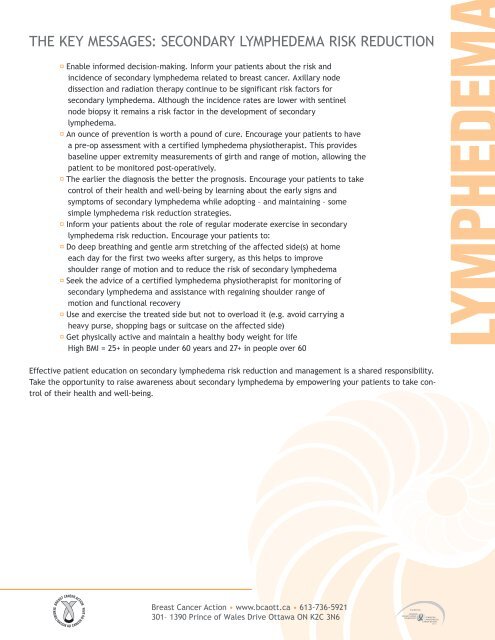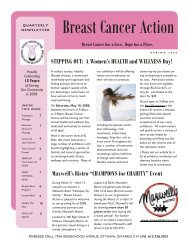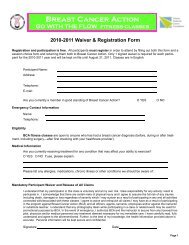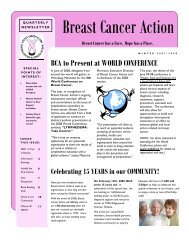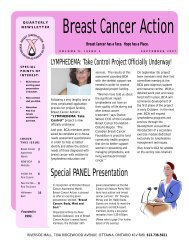Breast Cancer Patient Education: Secondary Lymphedema Key ...
Breast Cancer Patient Education: Secondary Lymphedema Key ...
Breast Cancer Patient Education: Secondary Lymphedema Key ...
You also want an ePaper? Increase the reach of your titles
YUMPU automatically turns print PDFs into web optimized ePapers that Google loves.
THE KEY MESSAGES: SECONDARY LYMPHEDEMA RISK REDUCTION Enable informed decision-making. Inform your patients about the risk andincidence of secondary lymphedema related to breast cancer. Axillary nodedissection and radiation therapy continue to be significant risk factors forsecondary lymphedema. Although the incidence rates are lower with sentinelnode biopsy it remains a risk factor in the development of secondarylymphedema. An ounce of prevention is worth a pound of cure. Encourage your patients to havea pre-op assessment with a certified lymphedema physiotherapist. This providesbaseline upper extremity measurements of girth and range of motion, allowing thepatient to be monitored post-operatively. The earlier the diagnosis the better the prognosis. Encourage your patients to takecontrol of their health and well-being by learning about the early signs andsymptoms of secondary lymphedema while adopting – and maintaining – somesimple lymphedema risk reduction strategies. Inform your patients about the role of regular moderate exercise in secondarylymphedema risk reduction. Encourage your patients to: Do deep breathing and gentle arm stretching of the affected side(s) at homeeach day for the first two weeks after surgery, as this helps to improveshoulder range of motion and to reduce the risk of secondary lymphedema Seek the advice of a certified lymphedema physiotherapist for monitoring ofsecondary lymphedema and assistance with regaining shoulder range ofmotion and functional recovery Use and exercise the treated side but not to overload it (e.g. avoid carrying aheavy purse, shopping bags or suitcase on the affected side) Get physically active and maintain a healthy body weight for lifeHigh BMI = 25+ in people under 60 years and 27+ in people over 60Effective patient education on secondary lymphedema risk reduction and management is a shared responsibility.Take the opportunity to raise awareness about secondary lymphedema by empowering your patients to take controlof their health and well-being.<strong>Breast</strong> <strong>Cancer</strong> Action • www.bcaott.ca • 613-736-5921301– 1390 Prince of Wales Drive Ottawa ON K2C 3N6


